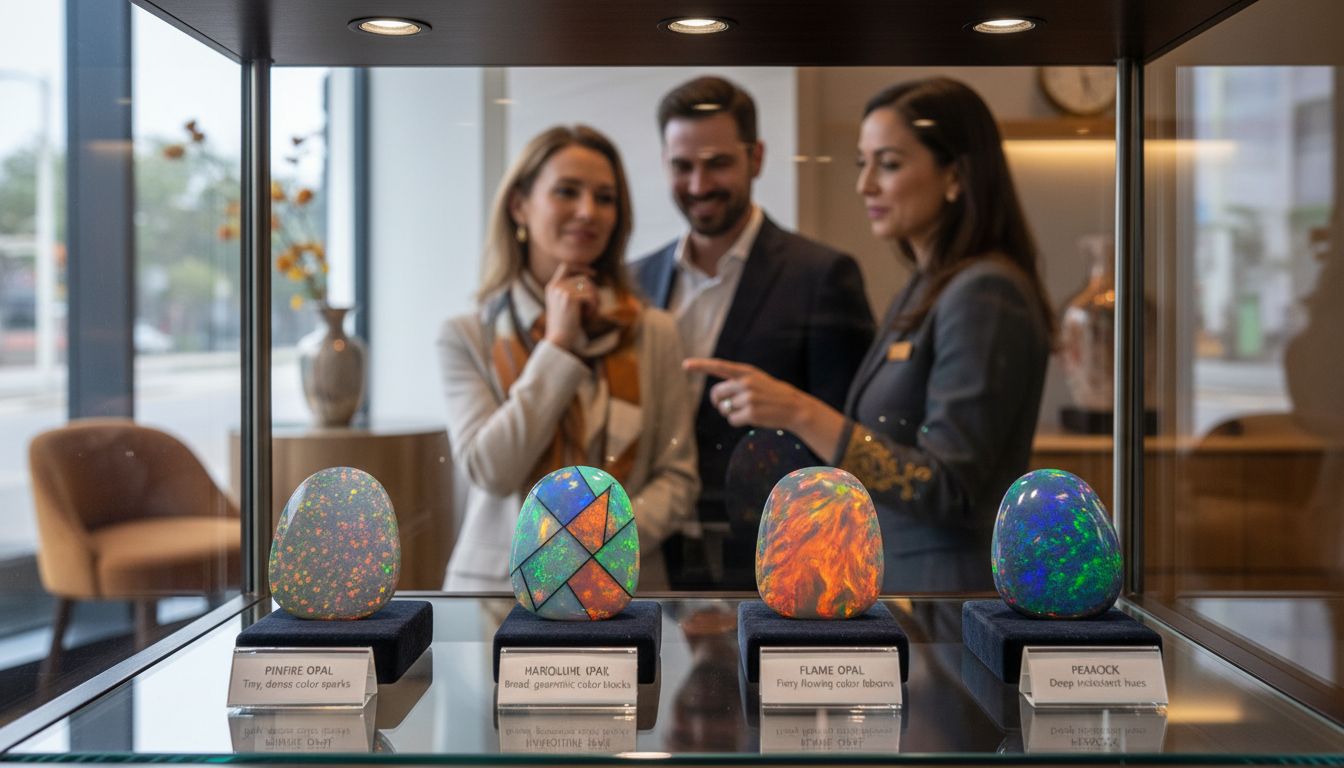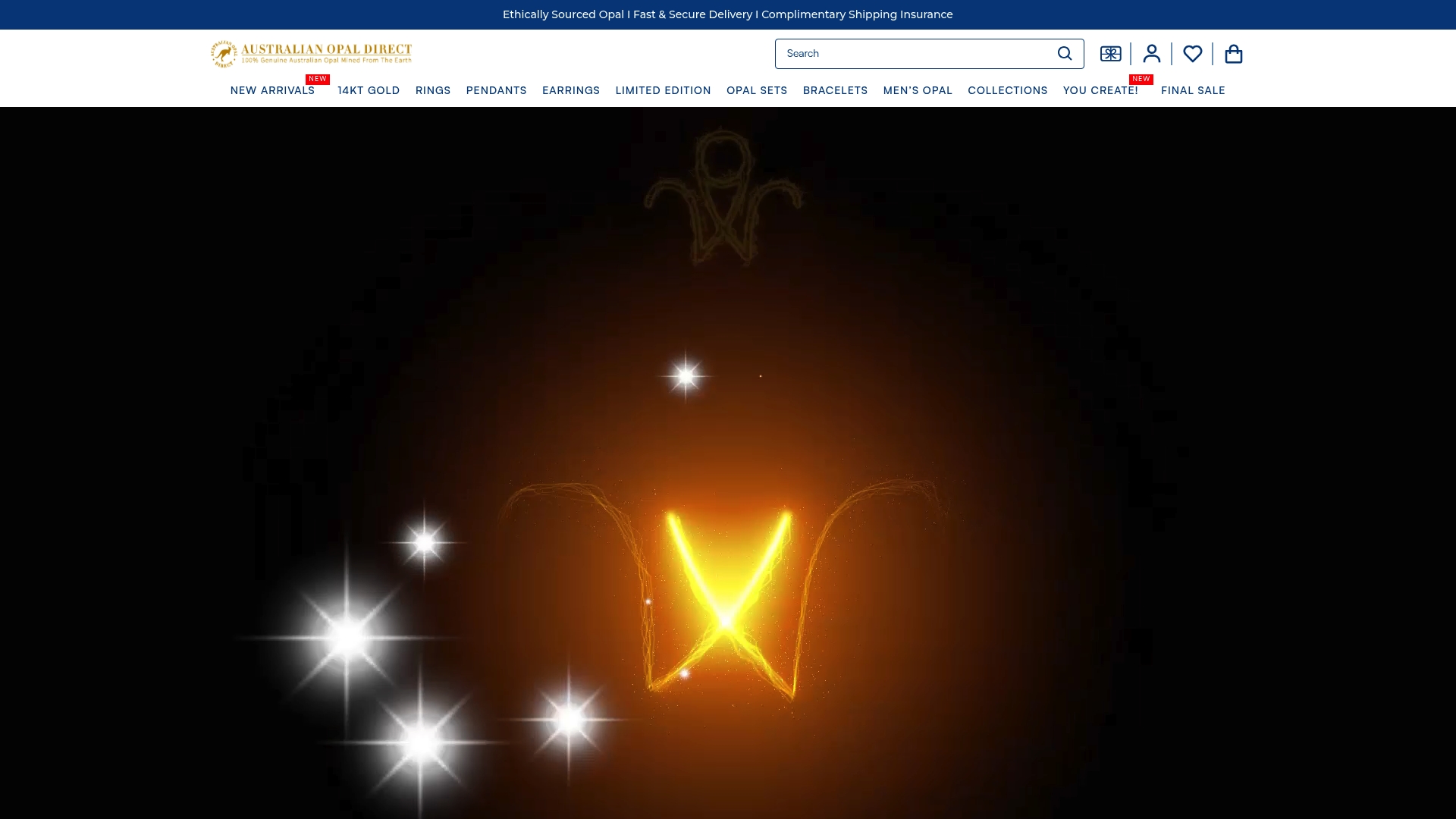What Is Opal Pattern? Complete Guide to Types and Value
Posted by AOD on 21st Nov 2025
What Is Opal Pattern? Complete Guide to Types and Value

Most american collectors are captivated by the allure of opal gemstones, especially those with rare and striking color patterns. With certain specimens fetching prices that soar well into five figures, understanding what defines an opal pattern can be both fascinating and financially rewarding. Each gemstone tells a hidden geological story through its color arrangement, and knowing how to recognize these patterns can help make informed choices when buying or appreciating opal jewelry.
Table of Contents
- Defining Opal Pattern And Its Significance
- Types Of Opal Patterns And Visual Features
- Formation Processes And Pattern Rarity
- Impact Of Pattern On Opal Value And Grading
- Tips For Collecting And Authenticating Patterns
Key Takeaways
| Point | Details |
|---|---|
| Opal Patterns | Opal patterns create unique visual landscapes that influence both aesthetic appeal and market value. |
| Types of Patterns | Notable opal patterns include pinfire, harlequin, flame, and peacock, each telling a distinct geological story. |
| Value Determinants | An opal’s value is significantly impacted by pattern complexity, color distribution, brightness, and rarity. |
| Authentication Strategies | Key methods for authenticating opals include visual inspection, inclusion analysis, and microscopic examination to ensure genuineness. |
Defining Opal Pattern and Its Significance
Opal patterns represent the intricate and mesmerizing arrangement of play-of-color within a gemstone, creating unique visual landscapes that fascinate collectors and jewelry enthusiasts. According to GIA, these patterns significantly influence an opal’s aesthetic appeal and market value, transforming each stone into a distinctive work of natural art.
The play-of-color emerges through specific microscopic silica spheres arranged within the opal’s internal structure, determining how light refracts and creates stunning visual effects. Gemologists recognize several distinctive patterns that make each opal truly one-of-a-kind. The most renowned patterns include:
- Pinfire: Tiny, concentrated color points scattered across the stone
- Harlequin: Large, geometric color patches resembling mosaic tiles
- Flame: Elongated color streaks mimicking dancing fire
- Peacock: Iridescent colors shifting from blue to green, reminiscent of a peacock’s plumage
Understanding these patterns goes beyond mere aesthetic appreciation. Each pattern represents a unique geological narrative, reflecting the precise conditions under which the opal formed. For more insights into the fascinating world of opals, explore our comprehensive guide on different types of opal.
The rarity and complexity of these patterns directly correlate with an opal’s value. Collectors and jewelry designers prize opals with distinctive, well-defined patterns that showcase vibrant, dynamic color interactions. While some patterns are more common, truly exceptional specimens with rare pattern configurations can command extraordinary prices in the global gemstone market.
Types of Opal Patterns and Visual Features
According to GIA, opal patterns represent a fascinating spectrum of visual expressions, encompassing distinctive types that transform each gemstone into a unique work of natural art. These patterns are characterized by their intricate arrangements of color and light, which emerge through microscopic silica sphere structures within the opal.
The most prominent opal patterns include:
- Pinfire: Tiny, intensely concentrated color points scattered delicately across the stone’s surface
- Harlequin: Large, geometric color patches resembling intricate mosaic tiles with sharp angular boundaries
- Flame: Elongated color streaks that dance and flow, mimicking the dynamic movement of fire
- Peacock: Iridescent colors shifting dramatically between deep blue and vibrant green, reminiscent of a peacock’s luminous plumage
Each pattern tells a unique geological story, revealing the precise environmental conditions that shaped the opal’s formation. Some patterns are exceedingly rare, with collectors and jewelry designers particularly prizing opals that showcase complex, well-defined color interactions. Understanding the nuanced world of opal colors can provide deeper insights into these mesmerizing patterns.
Beyond aesthetic appreciation, these patterns directly impact an opal’s market value. Rare configurations like the elusive harlequin pattern can dramatically increase a stone’s worth, with some exceptional specimens commanding premium prices among serious collectors and connoisseurs.
 The interplay of color, arrangement, and rarity transforms each opal into a miniature canvas of geological artistry.
The interplay of color, arrangement, and rarity transforms each opal into a miniature canvas of geological artistry.
![]()
Formation Processes and Pattern Rarity
Opal formation is a complex geological phenomenon that produces extraordinary patterns through intricate natural processes. According to GIA, the development of unique opal patterns involves a sophisticated sequence of geological events, including the deposition of homogeneous opal layers, vertical column formation, and subsequent silica gel precipitation.
The formation process reveals fascinating variations in pattern development:
- Sedimentary Formation: Occurs in rock cavities and underground spaces where silica-rich solutions gradually fill available spaces
- Replacement Patterns: Exemplified by unique Yowah nuts, where organic materials decay and are completely replaced by opal
- Hydrothermal Processes: Involving mineral-rich hot water solutions that deposit silica in intricate layers
- Volcanic Environments: Creating opals through rapid geological transformations in high-temperature settings
Some of the rarest patterns emerge from extraordinary geological circumstances. Our comprehensive guide to opal colors offers deeper insights into how these unique environmental conditions contribute to an opal’s distinctive visual characteristics.
The rarity of specific opal patterns is directly linked to the complexity and uniqueness of their formation processes. Collectors and gemologists prize opals with patterns that reflect exceptional geological narratives - each stone representing a miniature time capsule of earth’s transformative power. Extremely rare configurations like perfect harlequin or precise digit patterns can exponentially increase an opal’s value, making them highly sought-after treasures in the gemstone world.
Impact of Pattern on Opal Value and Grading
According to GIA, the pattern of an opal is a critical determinant of its overall value and grading, with certain configurations commanding substantially higher prices in the gemstone market. The intricate arrangement of color patches, brightness, and absence of visual interruptions play pivotal roles in assessing an opal’s worth.
Key factors influencing opal pattern valuation include:
- Color Distribution: Larger, more closely arranged color patches are typically more desirable
- Brightness and Intensity: Vibrant, high-contrast patterns increase market value
- Pattern Uniformity: Consistent, well-defined patterns are prized by collectors
- Rarity of Configuration: Unique patterns like harlequin can exponentially increase value
Our comprehensive guide to opal value provides deeper insights into the nuanced world of opal evaluation. Professional gemologists employ sophisticated grading systems that meticulously assess pattern characteristics, considering factors beyond simple visual appeal.
The most sought-after opals demonstrate extraordinary pattern complexity. Collectors and investors prioritize stones with rare, dynamic color interactions that tell a unique geological story. Exceptional specimens with pristine harlequin or perfect digit patterns can command premium prices, transforming these natural wonders from mere gemstones into coveted works of art with significant investment potential.
Tips for Collecting and Authenticating Patterns
Authenticating opal patterns requires a nuanced approach, as outlined by GIA, which emphasizes the critical importance of examining inclusions and play-of-color patterns to distinguish natural stones from synthetic or imitation varieties. Professional collectors develop a sophisticated eye for detecting subtle geological markers that reveal an opal’s true origins.
Key authentication strategies include:
- Visual Pattern Inspection: Carefully examine color distribution and brightness
- Inclusion Analysis: Look for natural mineral inclusions characteristic of genuine opals
- Light Performance: Assess how the stone refracts and reflects light across different angles
- Microscopic Examination: Use professional magnification to detect synthetic manufacturing signs
To ensure you’re acquiring an authentic specimen, explore our comprehensive guide to opal value which provides deeper insights into professional evaluation techniques. Reputable collectors understand that true value extends beyond surface appearances, requiring meticulous scientific assessment.
Advanced collectors recommend working with certified gemologists who can provide detailed documentation about an opal’s origin, pattern characteristics, and potential treatment history. The most valuable patterns emerge from natural geological processes, with rare configurations like perfect harlequin or unique digit patterns representing the pinnacle of opal collecting - true geological artworks that tell millions of years of Earth’s transformative story.
Discover the True Beauty of Opal Patterns with Australian Opal Direct
Choosing the perfect opal means understanding the mesmerizing patterns that make each stone unique. Whether you are captivated by the rare harlequin or the delicate pinfire, recognizing these patterns can be challenging when authenticity and value are on the line. Many collectors struggle to find genuine opals that showcase vibrant play-of-color combined with the geological stories these patterns tell. At Australian Opal Direct, we specialize in ethically sourced Australian opals that highlight those exceptional patterns described in the article, including flame, peacock, and digit configurations.

Explore our curated collection of stunning opal jewelry where each piece reflects rare natural artistry supported by transparent miner relationships and expert craftsmanship. Start your journey today by visiting Australian Opal Direct to find rings, pendants, and custom designs that celebrate the unique values of opal patterns. Learn more about how to evaluate opal value through our guides on opal colors and opal value. Secure your genuine opal treasure with confidence and bring history and vibrant life to your collection now.
Frequently Asked Questions
What are the different types of opal patterns?
Opal patterns include Pinfire, Harlequin, Flame, and Peacock. Each pattern exhibits unique color arrangements and visual characteristics that make each opal distinctive.
How do opal patterns affect a gemstone’s value?
The pattern of an opal significantly impacts its value. Rare configurations, such as Harlequin or other intricate designs, can dramatically increase the stone’s worth, while well-defined patterns and vibrant colors are also highly prized.
What is the play-of-color in opals?
Play-of-color refers to the captivating optical effect seen in opals, resulting from the arrangement of microscopic silica spheres within the stone. This phenomenon influences the visual appeal and patterns that emerge when light interacts with the opal.
How can I authenticate an opal’s pattern?
To authenticate an opal’s pattern, visually inspect the color distribution and brightness, analyze natural mineral inclusions, assess light performance, and, if possible, conduct a microscopic examination to identify any signs of synthetic manufacturing.




